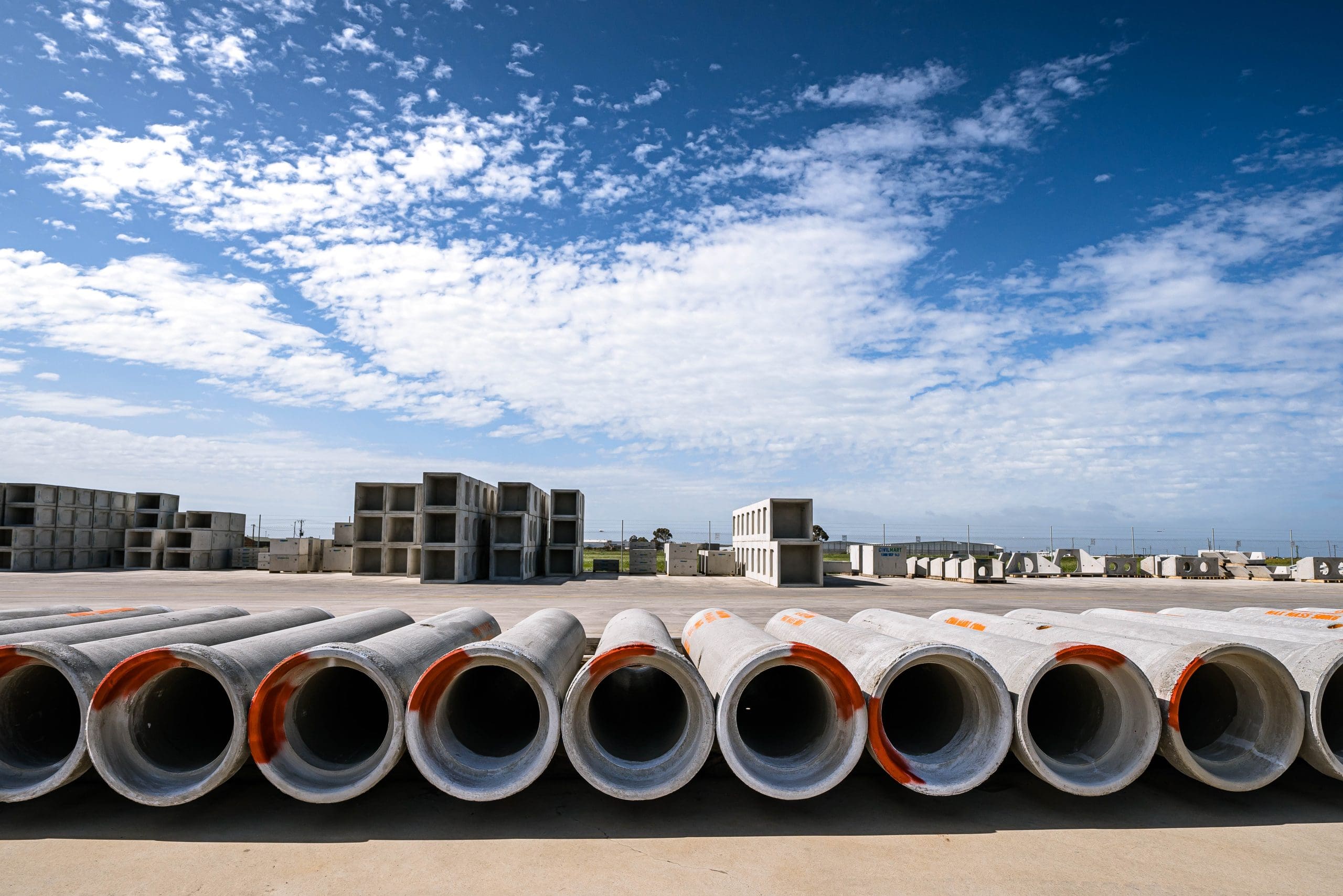Reinforced Concrete Pipes are one of our most popular products. Used primarily for stormwater drainage, Reinforced Concrete Pipes are a key building block in almost any subdivision, roadway or major infrastructure project. Before ordering, it’s important to understand different pipe types, sizes and configurations, to ensure you get the right product for the right job. As one of our most popular products, we are tried and true experts in Reinforced Concrete Pipe. Let us share our knowledge with you in this ultimate guide to Reinforced Concrete Pipes!
What is a Reinforced Concrete Pipe (RCP)?
A Reinforced Concrete Pipe (RCP) is a type of piping made from precast concrete, reinforced with steel rebar for added strength and durability. Available in an array of sizes, ranging from 300mm to 2100mm in diameter, Reinforced Concrete Pipes are used to direct the flow of stormwater runoff (and other liquids) beneath the surface of the earth. Most commonly used as in stormwater or sewer settings, RCP can also be used for large-scale irrigation projects, as culverts or in a range of other pipeline projects.
Why Reinforced Concrete Pipes?
Reinforced Concrete Pipe is the most common and most trusted product for pipelines and water transportation projects. It has been used for centuries in this role, alternatives have sprung up more recently that have caused some debate over which product is best.
High-Density Polyethylene (HDPE) pipes are made from high-grade, strength-tested plastic material and has been used in stormwater settings in recent times. HDPE pipes are considered to be a low-cost alternative to RCP given their price point at purchase. Given the additional costs involved in on-site installation however, including structural integrity tests, engineered backfill, on-site inspections and post-installation laser testing, total cost for HDPE pipes quickly adds up.
In addition to price, Reinforced Concrete Pipe has been trusted for centuries and has a proven 100-year lifespan. This reduces the need for infrastructure rehabilitation projects, further reducing the ongoing costs of choosing RCP. HDPE pipe is a much more recent product that simply does not have the raw data available to guarantee lifespan claims.
RCP Joint Configurations
There are three main types of joint configurations for reinforced concrete pipe; Flush Joint, Spigot-to-Spigot and Rubber Ring Joint. Typically, Flush Joint pipes are used for heavy-duty stormwater applications, Rubber Ring Joints are used for irrigation, and Spigot-to-Spigot pipes are used at the end of pipelines, to be installed into a precast concrete headwall.
Precast Concrete Classifications
Reinforced Concrete Pipe can be offered in a variety of “classes”. When discussing precast concrete, “class” typically refers to the finish of the concrete. Class 1 concrete is highest standard with the most rigorous specification and is only recommended for use in very special features of buildings of a monumental nature.
Where the term ‘class’ is used to define a Reinforced Concrete Pipe, is not meant to be a surface quality or ‘finish’ reference – like it could be if discussing pre-cast elements such as those to be used as a concrete ‘feature’.
In general terms, from a project specification or manufacturing perspective the look or ‘ finish’ of precast concrete element in underground applications is not typically a key requirement.
When it comes to Reinforced Concrete Pipe, ‘class’ is a term defined by the relevant Australian Standard (AS4058) that captures a wide variety of product considerations such as Size, Load, Watertightness or Pressure. These pre-defined classifications help manufacturers ‘grade’ the pipe, and visually marking on the product help both suppliers and customers quickly cross-reference the product in a stockpile or when stored on site.
To delve into this further, in the Australian marketplace manufacturers, specifiers and purchases of Reinforced Concrete Pipe typically refer to ‘class’ as the load capacity (or ‘strength’) of a pipe. Each class is typically recognised by a colour marking on the product.
However the selection of Reinforced Concrete Pipes cannot purely be driven by load capacity alone. Installation conditions are very important to ensure the correct ‘class’ of pipe is suitable for the given application. Australia Standard AS3725 defines options for installation conditions (i.e. trench, embankment etc) and backfill processes (i.e. embedment conditions). These options allow designers to determine the right combination of pipe ‘class’ and installation method, and ensure they strike the right balance between performance and a cost-effective solution.
Civilmart offer our range of Reinforced Concrete Pipe in Classes 2, 3 & 4. This ensures our customers have choice and flexibility when considering product selection to suit their project needs. Higher classes are available upon request.
Why Choose Civilmart?
Civilmart have been creating reinforced concrete pipe for over 70 years. That’s 70 years of experience creating some of Australia’s highest-quality precast concrete, helping to build Australia as it is today. Our range of Reinforced Concrete Pipes is unmatched in size, joint and class options, so get in touch with our team of experts today!
Join the Civilmart family
Stay up to date with latest product releases, newest industry innovations and more!


